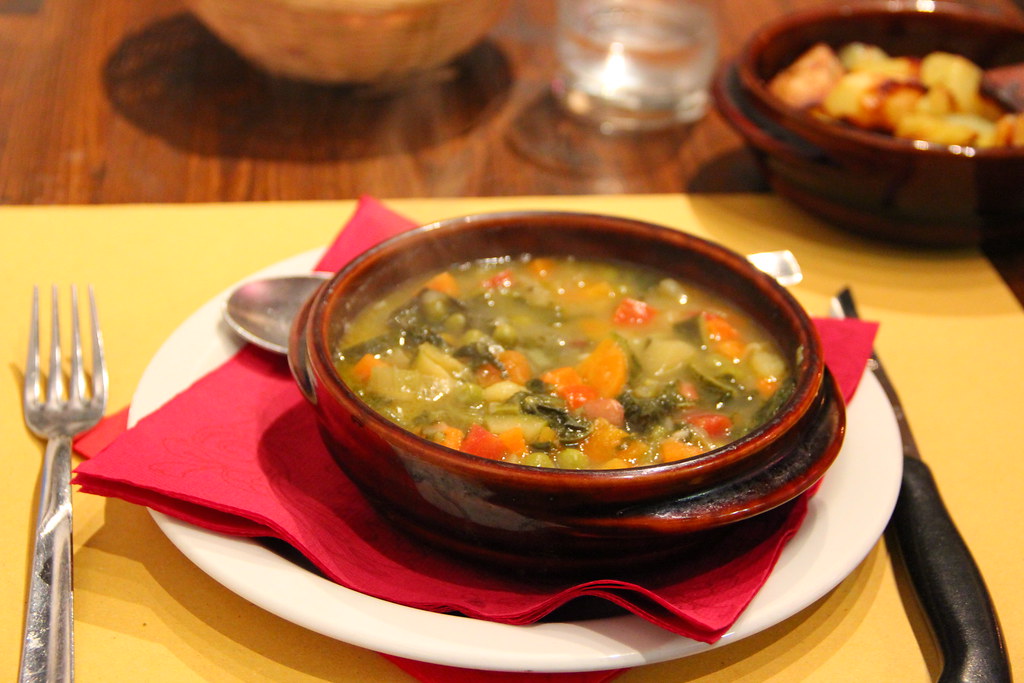One of the experiences that constantly teaches me new things about Italian behaviour standards is going out to eat dinner. I’ve mostly been making my own food at home (a lot of rice and veggies; also, I recently found some gluten-free tamari/soy sauce! Yay!), but I do go out every few days for dinner (often using the AIFS meal vouchers, which I highly recommend).
My two favourite restaurants so far are Masticabrodo and Golden View. (I’ll write restaurant reviews about these two places soon. Also, both participate in with AIFS’s meal voucher plan).
First off, Italians serve their food in courses. Even when ordering a simple dinner, they’ll sometimes ask which course you would like first. I’m used to having all of my meal available during dinner, so it has been interesting eating dinner this way.
My delicious (vegetarian and gluten free) minestrone soup at Masticabrodo. I was having dinner alone, and I think the waitress figured that I may as well have all my food — you can spot the (delicious) roasted potatoes in the background.
Water is not always included free with the meal. Italians often drink “fizzy” or mineral water, so the waiter always asks whether you’d prefer the water still or mineral. They do not serve water with ice, something very typical of American culture. I never drink iced water, so I actually really like this. Also, water is typically served out of a bottle, instead of the sneaky tap water you get in the U.S.
Ice cream is not as common a dessert item in Florence as is tiramisu, cheesecake and (sometimes) panna cotta. Crème brûlée and various types of mousse are also available in nicer restaurants. In the U.S., ice cream is a very common item on the dessert menu (often available in Japanese and Indian restaurants).
From what I’ve seen, gelato does not usually appear on restaurant menus. Gelato is found in “Gelaterias” (gelato booths/sweets stores) or in grocery stores.
Also, in Italy customers are not generally shepherded out a café or restaurant after the meal is over. I think this stems from the more Italian culture of enjoying a meal with family or friends; time is spend enjoying life through some leisure. In the U.S., it is socially expected of the diners to leave after finishing their meal. In a coffee shop, you are expected to purchase something every hour; there is basically a “drink minimum.” This is not part of Italian culture. If you buy one coffee, you may sit in a café for the rest of the day; you will not be asked to leave. America’s approach to meals is much more business like: once the goal of satisfying hunger is accomplished, the person leaves. In Italy places value on the process of appreciating the meal relishing the moment.
Random Cultural Differences:
America: It is polite to keep your hands in your lap/off of the table.
Italy: It is polite to keep your hands both on the table.
America: The waiter brings you the bill near the end of your meal/during dessert.
Italy: The waiters will not bring the bill until it is requested. Confused tourists/new study abroad students sometimes spend a confusingly long amount of time waiting around until this is realised. A simple “Il conto, per favore” is sufficient to request the bill.
America: The approach to alcohol is that you drink to get drunk.
Italy: Alcohol (like wine) is a part of Italian culture, and has its own way of fitting into social behaviour.
Age Limits: In America the legal age limit for purchasing alcohol is 21. In Italy, no one asks for proof of age when purchasing alcohol.
Written by: Fiona O-Young

